Particle Methods Simulations by Kinetic Theory Models of Human Crowds Accounting for Stress Conditions
Abstract
1. Plan and Aims of the Paper
2. Selection of a Crowd Model and Simulations
2.1. Requirements of the Computational Approach
2.2. Selection of a Computational Model
- models the quality of the venue, where corresponds to worst quality which, in practice, prevents motion, while models high quality which can allows high speeds, however depending on the local density, as increasing density reduces locally the speed.
- models the level of stress, where corresponds to absence of concentration, to a normal level of stress which is needed by a proper self-organization of the motion, and models the highest level of stress. The connection between level of stress and local density can be modeled by simple functions which depict how is not a fixed parameter, but it grows with the local density when the said density pass a critical threshold, e.g., .
- Interaction rate: A simple model of the rate of interaction between walkers is obtained by assuming that this rate is constant.
- Walking strategy: Walkers first select the walking direction, which ends up to correspond to the velocity direction, and subsequently adapt the speed to the local density pattern in their visibility zone.
- Selection of the velocity direction: According to [7], the strategy which leads to the velocity direction is a weighted selection out of three directions: (i) towards the trajectory going to the exit, (ii) attraction by the low gradient path, (iii) attraction by the main stream. The selection is driven by the local density and the parameter which models the level of stress. In more detail, attraction (ii) is enhanced by , while attraction (iii) is enhanced by .
- Perception of the density along the velocity direction: Once a velocity direction has been selected walkers perceive a density different from the real one as follows:where denotes the derivative along the direction . Hence, is higher (lower) that the real one in the presence of positive (negative) gradients, by a model which accounts for lower and higher bounds:
- Adjustment of the speed: Walkers, after perception of the density, adjust their speed to the perceived density conditions. The new speed can be modeled as follows:
- Stress-density reciprocal influence: A key feature of the dynamics is the interaction between local density and level of stress as when the local density tends to the maximal value also the local stress tends to limit value .
- Boundary conditions: The statement of the mathematical problem requires the implementation of boundary conditions which depend on the distance from the wall measured along the direction of motion. When this distance tends to zero the attraction by the trajectory towards the exit is enhanced with respect to the other directions.
2.3. Simulations of Crowds over a Bridge with Internal Obstacles
- The number of pedestrians in the simulations is of a higher order, namely of the order f instead of .
- The velocity is continuous rather than discrete in a fixed number of directions, while the speed is not related to the velocity diagram, but it accounts for local gradients.
- The individual decision processes which leads to the selection of the velocity direction account for the presence of obstacles.
- The dynamics accounts for the different level of stress and of their relation to local density.
- A stochastic computational method has been developed to take into account all specific features indicated in the above items.
2.4. Flows of Crowds Moving to Opposite Directions
3. Critical Analysis towards Safety Problems
Author Contributions
Funding
Conflicts of Interest
References
- Elaiw, A.; Al-Turki, Y.; Alghamdi, M. A critical analysis of behavioural crowd dynamics: From a modelling strategy to kinetic theory methods. Symmetry 2019, 11, 851. [Google Scholar] [CrossRef]
- Moussaïd, M. Moins la foule est dense, plus elle est imprévisible. 2019. Available online: https://www.pourlascience.fr/ (accessed on 18 October 2019).
- Albi, G.; Bellomo, N.; Fermo, L.; Ha, S.-Y.; Kim, J.; Pareschi, L.; Poyato, D.; Soler, J. Traffic, crowds, and swarms. From kinetic theory and multiscale methods to applications and research perspectives. Math. Models Methods Appl. Sci. 2019, 29, 1901–2005. [Google Scholar] [CrossRef]
- Schadschneider, A.; Chraibi, M.; Seyfried, A.; Tordeux, A.; Zhang, J. Pedestrian dynamics: From empirical results to modeling. In Crowd Dynamics Voume 1—Theory Models and Safety Problems; Gibelli, L., Bellomo, N., Eds.; Springer: Berlin/Heidelberg, Germany, 2018; pp. 63–102. [Google Scholar]
- Schadschneider, A.; Klingsch, W.; Kläpfel, H.; Kretz, T.; Rogsch, C.; Seyfried, A. Evacuation dynamics: Empirical results, modeling and applications. In Encyclopedia of Complexity and System Science; Springer: Berlin/Heidelberg, Germany, 2009; pp. 3142–3176. [Google Scholar]
- Bellomo, N.; Bellouquid, A.; Knopoff, D. From the micro-scale to collective crowd dynamics. Multiscale Model. Simul. 2013, 11, 943–963. [Google Scholar] [CrossRef]
- Bellomo, N.; Gibelli, L. Toward a mathematical theory of behavioral-social dynamics for pedestrian crowds. Math. Models Methods Appl. Sci. 2015, 25, 2417–2437. [Google Scholar] [CrossRef]
- Bellomo, N.; Gibelli, L.; Outada, N. On the interplay between behavioral dynamics and social interactions in human crowds. Kinet. Relat. Models 2019, 12, 397–409. [Google Scholar] [CrossRef]
- Bertozzi, A.L.; Rosado, J.; Short, M.B.; Wang, L. Contagion shocks in one dimension. J. Stat. Phys. 2015, 158, 647–664. [Google Scholar] [CrossRef]
- Wang, L.; Short, M.; Bertozzi, A.L. Efficient numerical methods for multiscale crowd dynamics with emotional contagion. Math. Models Methods Appl. Sci. 2017, 27, 205–230. [Google Scholar] [CrossRef]
- Bellomo, N.; Bellouquid, A.; Chouhad, N. From a multiscale derivation of nonlinear cross-diffusion models to Keller-Segel models in a Navier-Stokes fluid. Math. Models Methods Appl. Sci. 2016, 26, 2041–2069. [Google Scholar] [CrossRef]
- Burini, D.; Chouhad, N. Hilbert method toward a multiscale analysis from kinetic to macroscopic models for active particles. Math. Models Methods Appl. Sci. 2017, 27, 1327–1353. [Google Scholar] [CrossRef]
- Burini, D.; Chouhad, N. A multiscale view of nonlinear diffusion in biology: From cells to tissues. Math. Models Methods Appl. Sci. 2019, 29, 791–823. [Google Scholar] [CrossRef]
- Burini, D.; De Lillo, S. On the complex interaction between collective learning and social dynamics. Symmetry 2019, 11, 967. [Google Scholar] [CrossRef]
- Helbing, D. Traffic and related self-driven many-particle systems. Rev. Mod. Phys. 2001, 73, 1067–1141. [Google Scholar] [CrossRef]
- Helbing, D.; Farkas, I.; Vicsek, T. Simulating dynamical feature of escape panic. Nature 2000, 407, 487–490. [Google Scholar] [CrossRef] [PubMed]
- Helbing, D.; Johansson, A. Pedestrian crowd and evacuation dynamics. In Encyclopedia of Complexity and System Science; Springer: Berlin/Heidelberg, Germany, 2009; pp. 6476–6495. [Google Scholar]
- Yin, J.; Zheng, X.-M.; Tsaur, R.C. Occurrence mechanism and copying paths of accidents of highly aggregated tourist crowds based on systems dynamics. PLoS ONE 2019, 14. [Google Scholar] [CrossRef] [PubMed]
- Elmoussaoui, A.; Argoul, P.; Elrhabi, M.; Hakim, A. Discrete kinetic theory for 2-Dmodeling of a moving crowd: Application to the evacuation of a non-connected bounded domain. Comput. Math. Appl. 2018, 75, 1159–1180. [Google Scholar] [CrossRef]
- Kim, D.; Quaini, A. A kinetic theory approach to model pedestrian dynamics in bounded domains with obstacles. Kinet. Relat. Models 2019, 12, 1273–1296. [Google Scholar] [CrossRef]
- Bird, G.A. Molecular Gas Dynamics and the Direct Simulation of Gas Flows; Oxford University Press: Oxford, UK, 1994. [Google Scholar]
- Aristov, V.V. Direct Methods for Solving the Boltzmann Equation and Study of Nonequilibrium Flows; Springer: New York, NY, USA, 2001. [Google Scholar]
- Barbante, P.; Frezzotti, A.; Gibelli, L. A kinetic theory description of liquid menisci at the microscale. Kinet. Relat. Models 2015, 8, 235–254. [Google Scholar]
- Pareschi, L.; Toscani, G. Interacting Multiagent Systems: Kinetic Equations and Monte Carlo Methods; Oxford University Press: Oxford, UK, 2013. [Google Scholar]
- Dimarco, G.; Pareschi, L. Numerical methods for kinetic equations. Acta Numer. 2014, 23, 369–520. [Google Scholar] [CrossRef]
- Ronchi, F.; Nieto Uriz, F.; Criel, X.; Reilly, P. Modelling large-scale evacuation of music festival. Fire Saf. 2016, 5, 11–19. [Google Scholar] [CrossRef]
- Ronchi, E.; Nilsson, D. Pedestrian movement in smoke, Data and Modeling approaches. In Crowd Dynamics Voume 1—Theory Models and Safety Problems; Gibelli, L., Bellomo, N., Eds.; Springer: Berlin/Heidelberg, Germany, 2018; pp. 37–62. [Google Scholar]
- Kinateder, M.; Wirth, T.D.; Warren, W.H. Crowd dynamics in virtual reality. In Crowd Dynamics Voume 1— Theory Models and Safety Problems; Gibelli, L., Bellomo, N., Eds.; Springer: Berlin/Heidelberg, Germany, 2018; pp. 11–12. [Google Scholar]
- Talmann, D.; Musse, S.R. Crowd Simulation; Springer: Berlin/Heidelberg, Germany, 2007. [Google Scholar]
- Zhan, B.; Monekosso, D.-N.; Remagnino, P.; Velastin, S.A.; Xu, L.-Q. Crowd analysis: A survey. Mach. Vis. Appl. 2008, 19, 345–357. [Google Scholar] [CrossRef]
- Wijermans, N.; Conrado, C.; van Steen, M.; Martella, C.; Li, J.-L. A landscape of crowd management support: An integrative approach. Saf. Sci. 2016, 86, 142–164. [Google Scholar] [CrossRef]
- Bellomo, N.; Bellouquid, A. On multiscale models of pedestrian crowds from mesoscopic to macroscopic. Commun. Math. Sci. 2015, 13, 1649–1664. [Google Scholar] [CrossRef]
- Bellomo, N.; Knopoff, D.; Soler, J. On the difficult interplay between life “complexity” and mathematical sciences. Math. Models Methods Appl. Sci. 2013, 23, 1861–1913. [Google Scholar] [CrossRef]
- Knopoff, D.; Nieto, J.; Urrutia, L. Numerical simulation of a multiscale cell motility model based on the kinetic theory of active particles. Symmetry 2019, 11, 1003. [Google Scholar] [CrossRef]
- Moussaid, M.; Helbing, D.; Garnier, S.; Johanson, A.; Combe, M.; Theraulaz, G. Experimental study of the behavioral underlying mechanism underlying self-organization in human crowd. Proc. R. Soc. B Biol. Sci. 2009, 276, 2755–2762. [Google Scholar] [CrossRef] [PubMed]
- Burger, M.; Düring, B.; Kreusser, L.M.; Markowich, P.A.; Schönlieb, C.-B. Pattern formation of a nonlocal, anisotropic interaction model. Math. Models Methods Appl. Sci. 2018, 28, 409–451. [Google Scholar] [CrossRef]
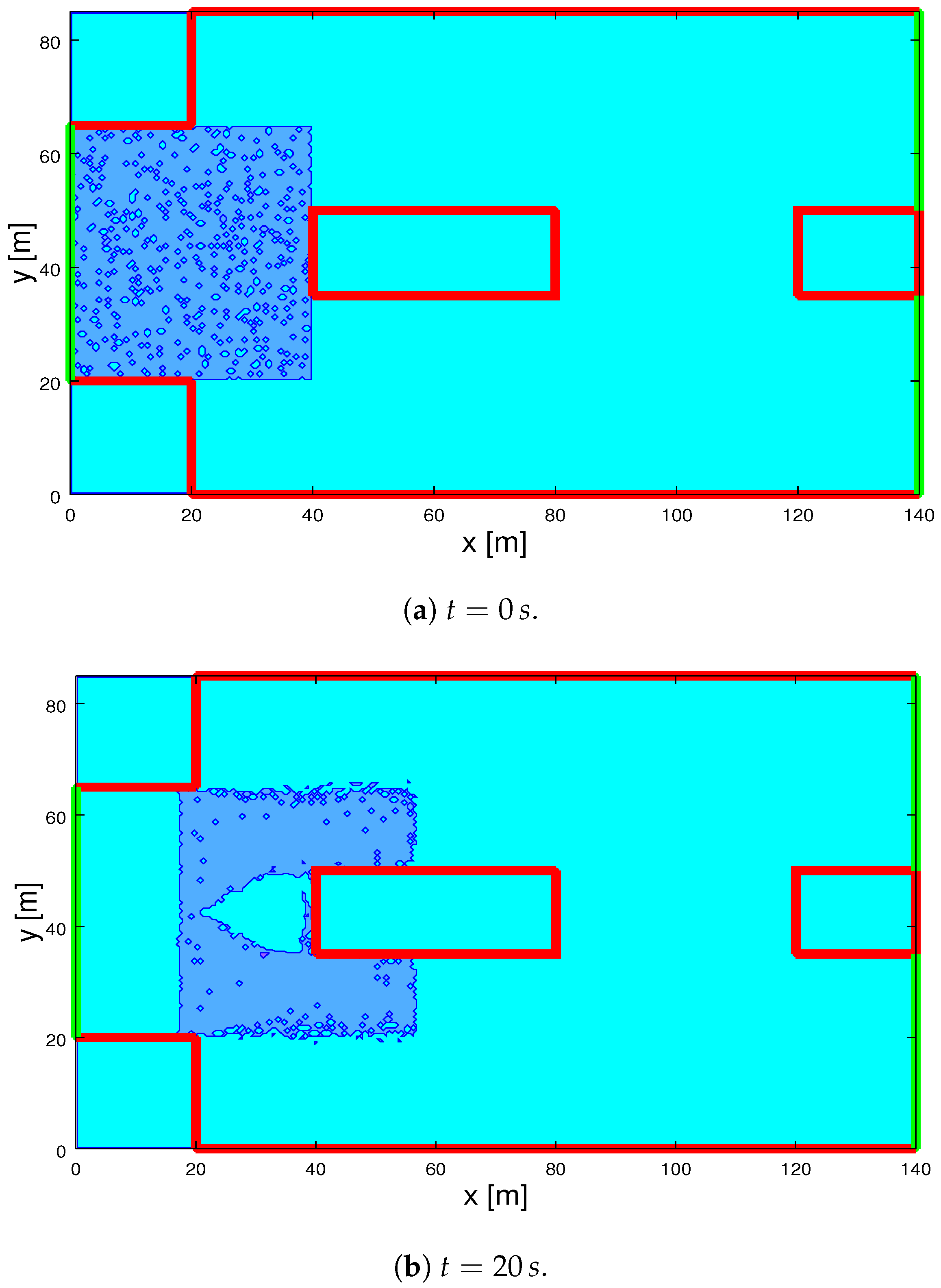
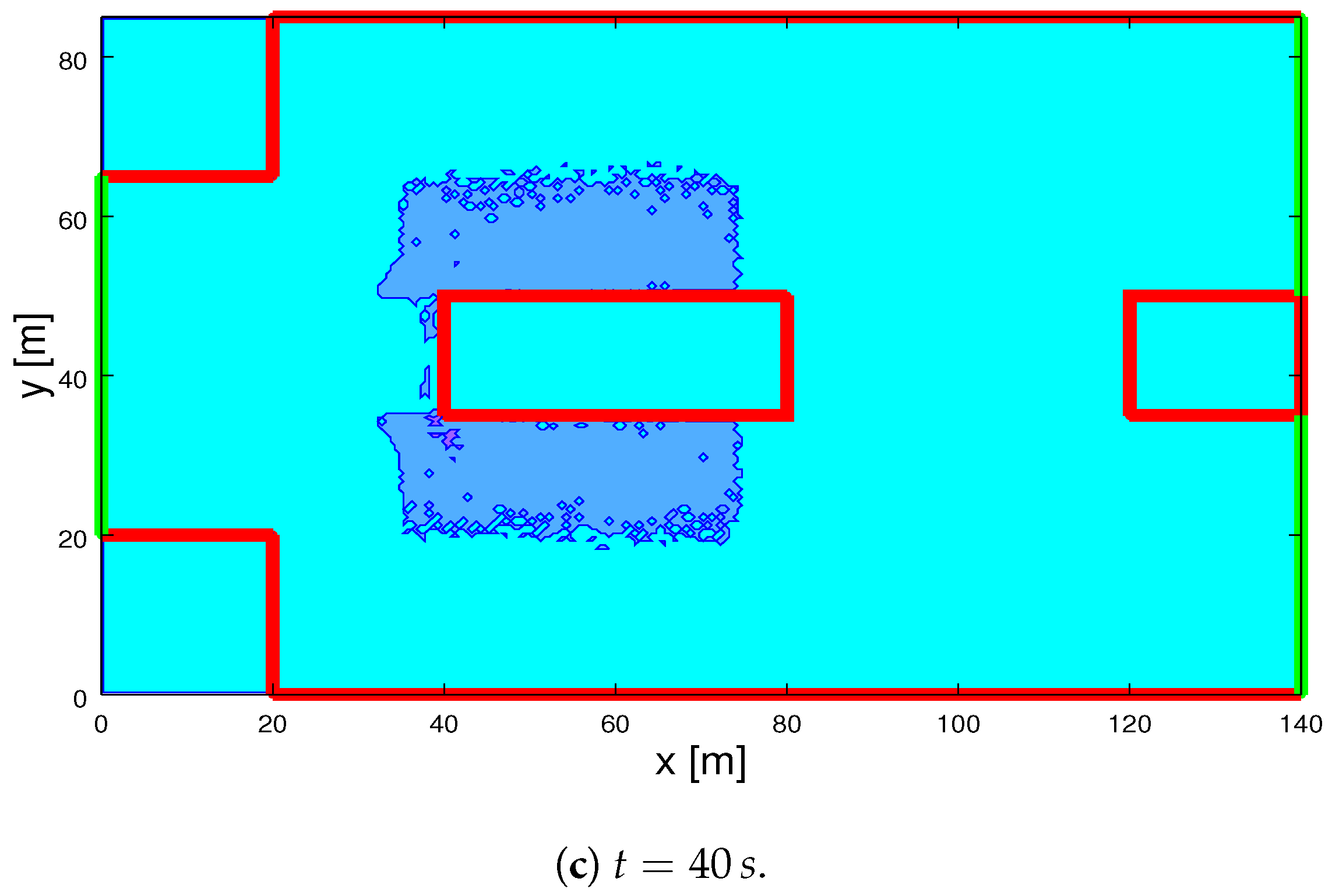
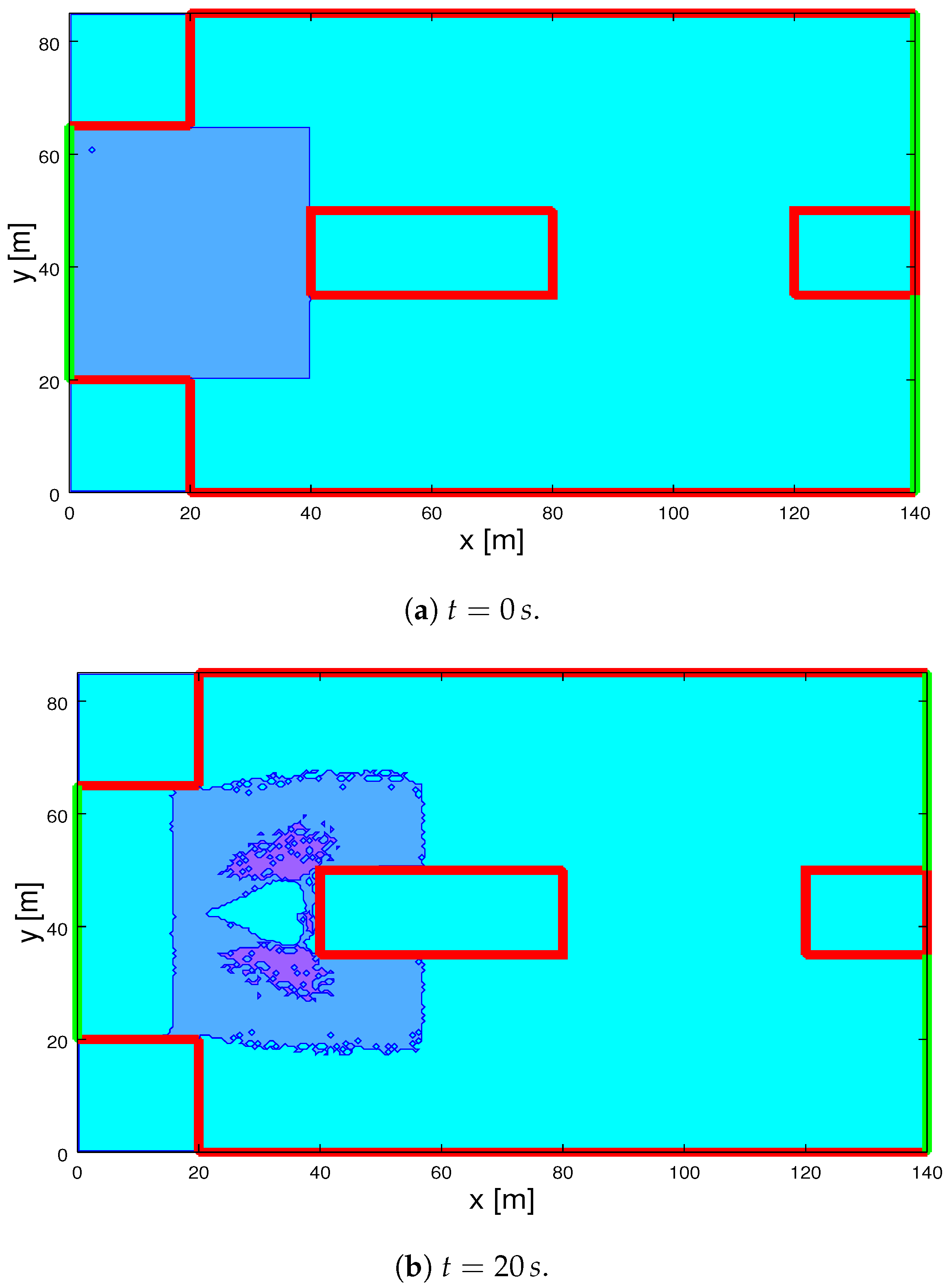
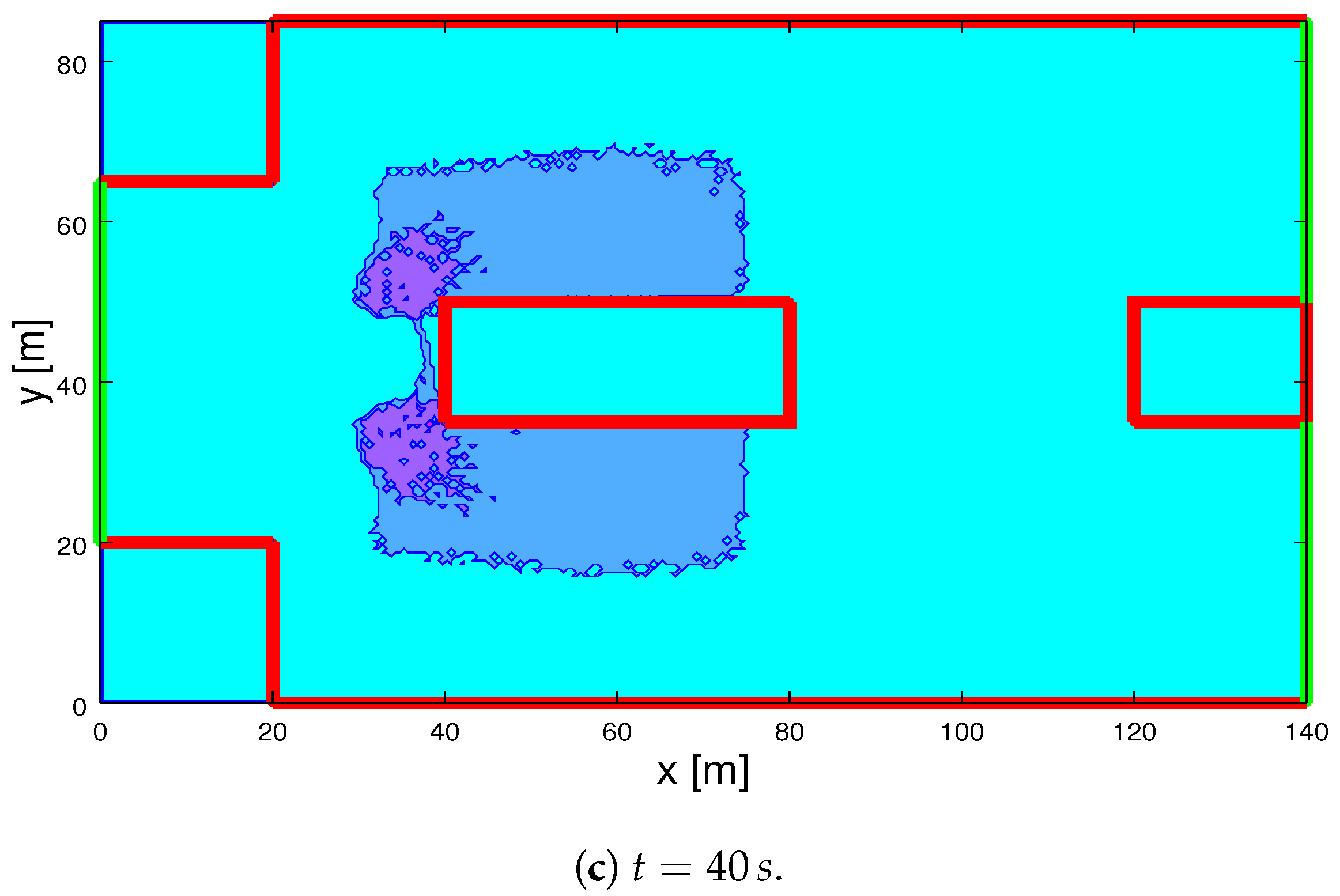
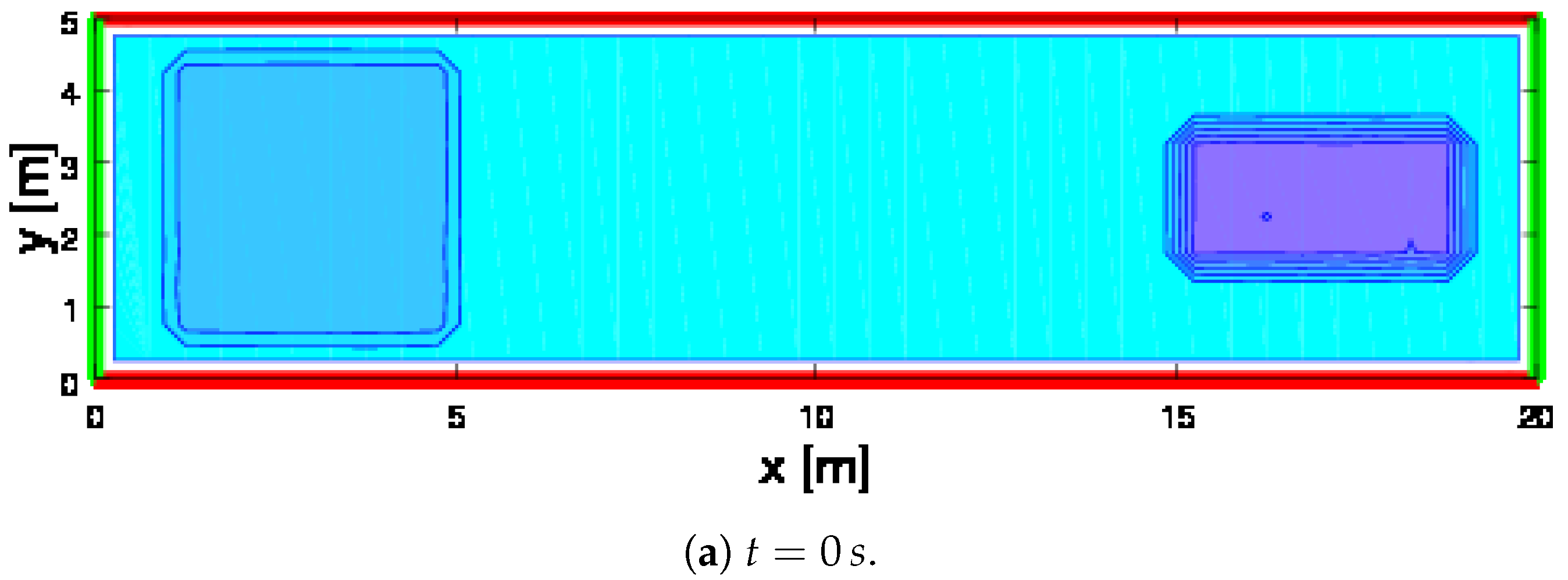
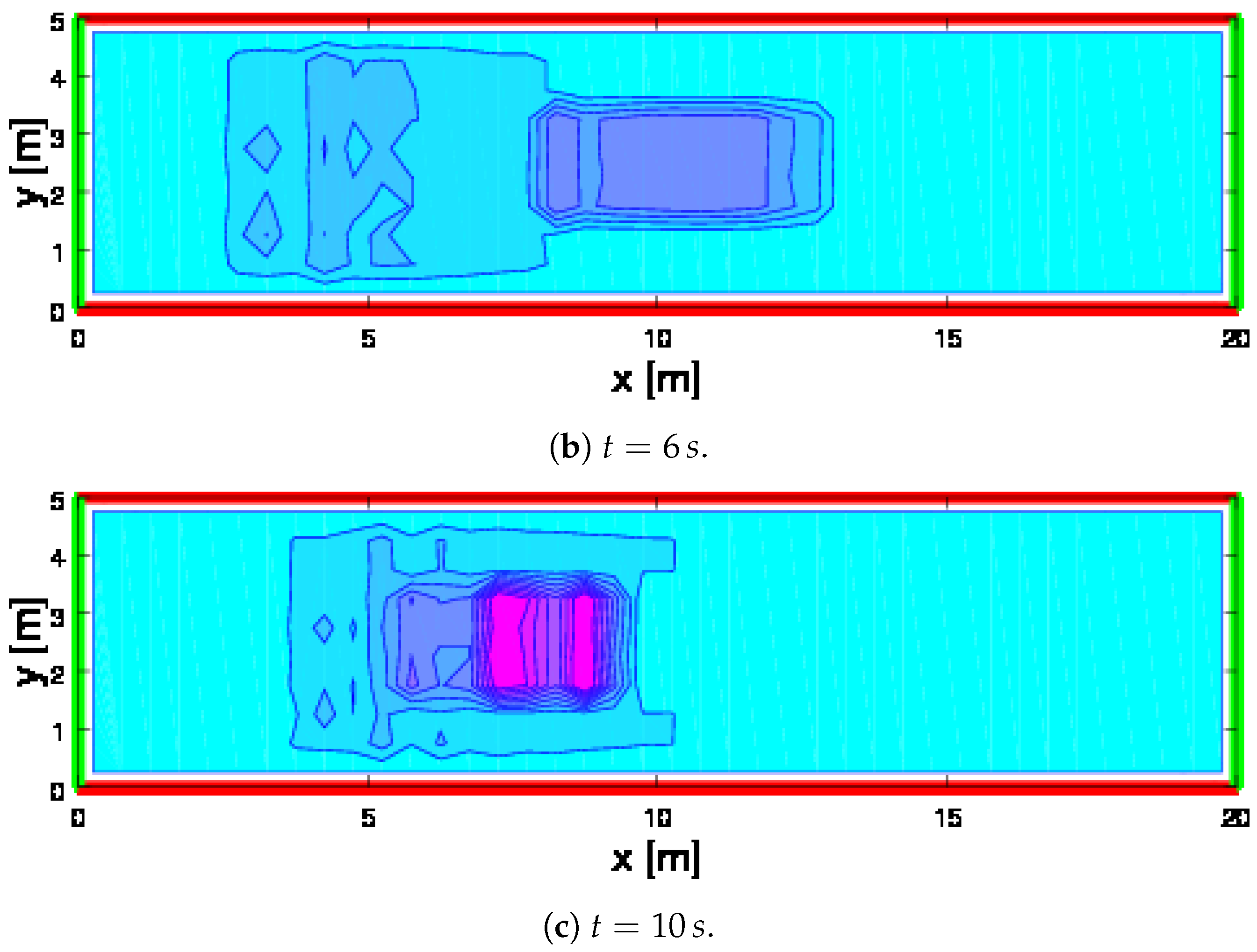
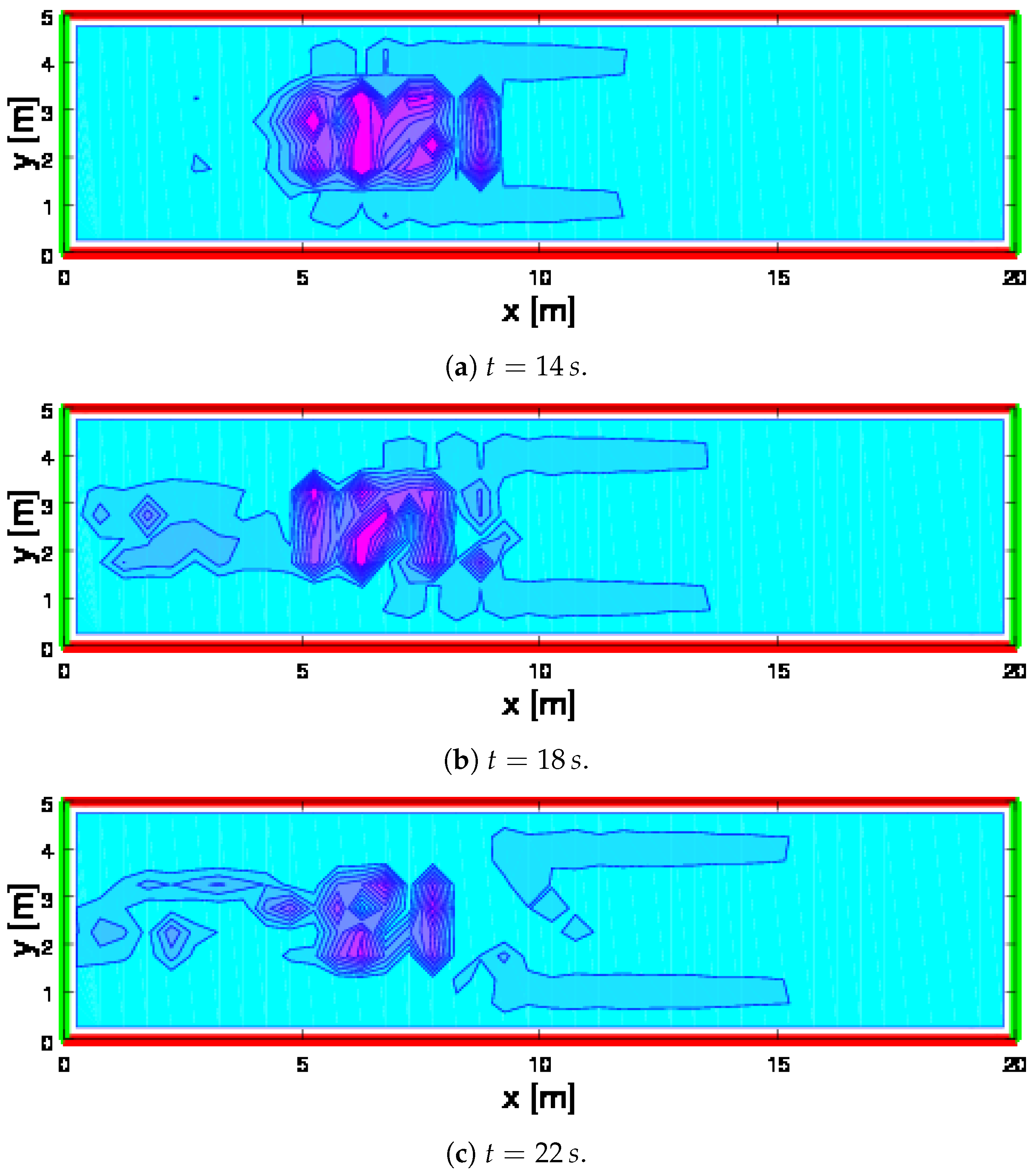
© 2019 by the authors. Licensee MDPI, Basel, Switzerland. This article is an open access article distributed under the terms and conditions of the Creative Commons Attribution (CC BY) license (http://creativecommons.org/licenses/by/4.0/).
Share and Cite
Elaiw, A.; Al-Turki, Y. Particle Methods Simulations by Kinetic Theory Models of Human Crowds Accounting for Stress Conditions. Symmetry 2020, 12, 14. https://doi.org/10.3390/sym12010014
Elaiw A, Al-Turki Y. Particle Methods Simulations by Kinetic Theory Models of Human Crowds Accounting for Stress Conditions. Symmetry. 2020; 12(1):14. https://doi.org/10.3390/sym12010014
Chicago/Turabian StyleElaiw, Ahmed, and Yusuf Al-Turki. 2020. "Particle Methods Simulations by Kinetic Theory Models of Human Crowds Accounting for Stress Conditions" Symmetry 12, no. 1: 14. https://doi.org/10.3390/sym12010014
APA StyleElaiw, A., & Al-Turki, Y. (2020). Particle Methods Simulations by Kinetic Theory Models of Human Crowds Accounting for Stress Conditions. Symmetry, 12(1), 14. https://doi.org/10.3390/sym12010014




